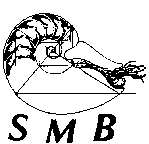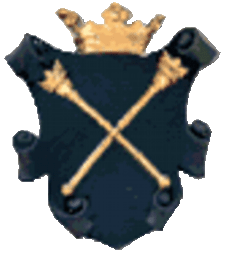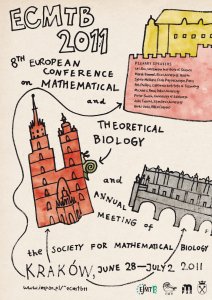The recommended poster size is ISO A0 (0.84 m x 1.19 m) in portrait
orientation.
The whole poster stand is 0.98 m in width x 2.0 m in height
from the floor level.
- Masakazu Akiyama (Faculty of Mathematics, Kyushu University): A Mathematical Model of Cleavage
- Daniel Arbelaez Alvarado (Universidad de los Andes, Departamento de Ingenieria Civil y Ambiental. Bogota, Colombia.): A mathematical model for assessing the spraying as a vector control strategy for Chagas disease in Colombia
- Takeshi Asakawa (System Technologies Laboratories , SONY Corporation): Mathematical model of the mammalian circadian center as a many-body system of the limit cycle oscillators
- Irem Atac (Researcher at Kocaeli University, TURKEY): On The Stability of the Steady-State Solutions of Cell Equations in a Tumor Growth Model
- Archana Bajpai (Microsoft Research-University of Trento CoSBi): Computational analysis of the cell growth regulatory network of fission yeast cells
- Annabelle Ballesta (INRIA): A Combined Experimental and Mathematical Approach for Molecular-based Personalization of Irinotecan Circadian Delivery
- Jörg Bandura (Theoretical Biology, IZMB, University of Bonn, Germany): Cell migration inspired design of crawling robots
- David Basanta (H. Lee Moffitt Cancer Center & Research Institute): The role of genetic and environmental insults in glioblastoma carcinogenesis
- Anja Bethge (Competence Center Bioinformatics, Institute for Applied Computer Science, University of Applied Sciences Stralsund, Germany): Are metastases from metastases clinically relevant? A novel computer model helps understanding the metastatic progression
- Sebastian Binder (Systems Immunology, Helmholtz Centre for Infection Research): Intra-host dissemination dynamics of Borrelia sp. during Lyme disease
- Martin Bock (Bonn University, Theoretical Biology): On shape and force -- from single to interactive cell motion
- Ansgar Bohmann (Heidelberg University): Modeling Viral Spread on Tissue or Cell Culture Level
- Dimitra Bon (GOETHE UNIVERSITY FRANKFURT INSTITUTE OF BIOSTATISTICS AND MATHEMATICAL MODELLING 60590 FRANKFURT (MAIN), GERMANY): PK-PD Models for viral kinetics in patients with HCV
- Marta Borowska (Department of Medical Informatics, Institute of Computer Science, University of Bialystok, Sosnowa 64, 15-887 Bialystok, Poland): Synchronization in coupled nonlinear dynamical systems
- Evert Bosdriesz (Systems Bioinformatics, Vrije Universiteit Amsterdam): The cost and benefit of enzyme expression
- Victor F Brena-Medina (University of Bristol): Wave-pinning Mathematical Model of Plant Root Hair Initiation
- Lutz Brusch (Dresden University of Technology, Germany): A model for cyst lumen expansion and size regulation via fluid secretion
- Katarzyna Buszko (Department of Theoretical Foundations of Bio-medical Science and Medical Informatics,Nicolaus Copernicus University, Collegium Medicum in Bydgoszcz, ul. Jagiellońska 13, 85-094 Bydgoszcz, Poland): Transient chaos measurements using finite-time Lyapunov exponents in model of population dynamics
- James Clarke (University of Bath, UK): Control of Chlamydia from a public health viewpoint
- Andres Cortes (Uppsala University, Sweden): The Utility of Thornthwaite and Hamon Models for Potential Evotranspiration and Drought Index Calculation: the Case of Wild Common Bean
- Huguette Croisier (School of Mathematical Sciences, Univeristy of Nottingham): A mathematical model of calcium dynamics in airway smooth muscle cells including store-operated calcium entry
- Fordyce Davidson (Division of Mathematics, University of Dundee): Hyphal tip morphogenesis
- Jaber Dehghany (Helmholtz Centre for Infection Research): Computer modeling of insulin secretory granules' dynamics in pancreatic betacell
- Aurelio V de los Reyes (Institute of Molecular Life Sciences, University of Zurich): Analysis of Feedback in GAL Signalling Cascade
- Bernd-Simon Dengel (University of Stuttgart, Germany): 3D image reconstruction of biological tissues
- Edgar Diaz Herrera (California State University, Los Angeles and California Institute of Technology): Turing Theory in an Epidemiological Model
- Gaelle Diserens (Philip Morris International R&D, Philip Morris Products S.A., Neuchâtel, Switzerland): Modeling Early Initiation Processes in Smoking-Induced Lung Adenocarcinomas
- Wen Duan (Auckland University, New Zealand): Mathematical modelling of adult GnRH neurons in the mouse brain
- Jorge Duarte (ISEL - Engineering Superior Institute of Lisbon): Chaos and crises in a model for cooperative hunting
- Claire Dufourd (UMR PVBMT, CIRAD): Spatio-temporal modeling of Aedes albopictus dispersal in Réunion Island. Application to the release of Sterile Insects
- Thomas Dunton (University of Oxford): A discrete simulation of protein movement and protein-protein interactions in a biological membrane
- Federico Elias Wolff (Chalmers University of Technology, Department of Applied Physics): Models for extinction in metapopulations
- Fadoua El Moustaid (African Institute for Mathematical Sciences, Stellenbosch University, 6-8 Melrose road, Muizenberg 7945, Cape town, South Africa): Mathematical modeling of bacterial attachment to surfaces: Biofilm initiation
- Przemyslaw Gagat (Department of Genomics, Faculty of Biotechnology, University of Wroclaw, ul. Przybyszewskiego 63/77, 51-148 Wroclaw, Poland): Evolution of protein targeting via endomembrane system to primary plastids
- Diana Garcia Lopez (University of Manchester): Specialist-v-generalist host-parasite interactions: influence on the stochastic dynamics of bacteria-phage infection
- Eva Gehrmann (TU Darmstadt): Boolean versus continuous dynamics on simple two-gene modules
- Wojciech Goch (Uniwersytet Warszawski): The range of fluctuations of number of zinc ions depends on the ligand binding reaction rate constant and the initial concentration
- Meltem Gölgeli (Helmholtz Zentrum München Institute of Biomathematics and Biometry): A stochastic modelling approache for bacterial cell-cell communication
- Didier Gonze (Université Libre de Bruxelles): Modeling circadian clocks as coupled damped oscillators
- Fabio Grizzi (IRCCS Istituto Clinico Humanitas, Rozzano, Milan, Italy.): Fractal Geometry: a helpful way for looking cancer complexity
- Dorota Herman (Center for Systems Biology, School of Biosciences, University of Birmingham, Edgbaston, Birmingham B15 2TT, UK): Evolutionary optimization of negative and co-operative autoregulation in RK2 plasmids
- Ana Hernandez (Centro de investigación y de estudios avanzados del instituto politecnico nacional CINVESTAV-IPN Unidad Mérida): Body mass variation in a two-dimensional regular network
- Nadine Hohmann (Centre for Information Services and High Performance Computing, TU Dresden): Mechanisms for liver size regulation
- William Holmes (University of British Columbia): Symmetry Breaking and Cellular Polarization in Motile Cells
- Satomi Iino (Graduate School of Humanities and Sciences, Nara Women's University, Nara, Japan): Model of coexistence of fish by mating territory
- Jędrzej Jabłoński (Uniwersytet Warszawski; Wydział Matematyki, Informatyki i Mechaniki): Size-structured population model with discontinuous growth rate
- Harsh Jain (Mathematical Biosciences Institute, Ohio State University): Mathematical Validation of a Novel Implantable Oxygen Sensor
- Roman Jaksik (Silesian University of Technology): MicroImage as a tool for microarray image artifacts correction
- Winfried Just (Department of Mathematics, Ohio University): Boolean dynamics vs. ODE dynamics
- Atsushi Kamimura (Institute of Industrial Science, The University of Tokyo): Tradeoff of Information Transmission and Decoding with Intracellular Kinetics
- Joanna Kawka (University of Heidelberg): Modeling of Beta-catenin signaling in Medulloblastoma
- Toshiya Kazama (Department of Mathematical and Life Sciences, Hiroshima University): A mathematical model for the mode transition of locomotion in Amoeba proteus
- David Kelly (University of Bristol): Methods to model (and quantify the complexity of) bio-molecular conformational dynamics
- Harald Kempf (Frankfurt Institute for Advanced Studies): Optimising chemo- and radiotherapeutic treatment protocols using synergy and tumour synchronisation
- Adnan Khan (Lahore University of Management Sciences): A Stochastic Model for Calcium Regulation in Spines
- Agnieszka Kitlas (Department of Medical Informatics, Institute of Computer Science, University of Białystok): Analysis of the uterine contractility: wavelet cross-correlation function and wavelet coherence measure
- Ryusuke Kon (University of Vienna): Permanence induced by life-cycle resonances
- Lubomir Kostal (Institute of Physiology, AS CR, v.v.i., Videnska 1083, Praha 4, Czech Republic): Entropy and Fisher information based measures of statistical dispersion
- Pawel Krupinski (Computational Biology and Biological Physics Group, Department of Theoretical Physics, Lund University, Lund, Sweden): Interplay of mechanical and biochemical signals in plant morphogenesis
- Pawel Krupinski (Computational Biology and Biological Physics Group, Department of Theoretical Physics, Lund University, Lund, Sweden): Molecular and mechanical interactions in early mammalian embryo
- Peter Kühl (University of Basle, Switzerland): Stochastic time-time interactions in biocatalytic and signalling systems
- Petr Lansky (Institute of Physiology, Academy of Sciences of the Czech Republic): Multiple neuronal spike trains observed in a short-time window
- Alexei Lapin (University of Stuttgart, Germany): Stirred Bioreactor Heating: Temperature Experience of a Single Organism
- Chang Hyeong Lee (Ulsan National Institute of Science and Technology): Recent Methods for Computations of Reaction Networks
- Jonggul Lee (Konkuk University): An open tank system of valveless pumping
- Nam-Kyung Lee (Department of Physics, Sejong University): Relaxation of End-Grafted DNA Chains
- Felix Lenk (TU Dresden / Institute of Food Technology and Bioprocess Engineering / Chair of Bioprocess Engineering): A structured growth model for hairy roots of beetroot (Beta vulgaris)
- Anne-Cécile Lesart (UJF-Grenoble 1, CNRS, Laboratory TIMC-IMAG UMR 5525, DyCTiM research team, Grenoble, F-38041, France): A Computational Model of Vascular Tumour Growth as Observed by Intravital Microscopy through a Dorsal Skinfold Chamber on the Mouse
- Bartosz Lisowski (M. Smoluchowski Institute of Physics and M. Kac Complex Systems Research Center, Jagiellonian University, Reymonta 4, 30-059 Kraków, Poland): Molecular Motor-Cargo systems: Modeling energetics of the kinesin with different approaches
- Horacio Lopez-Menendez (Zaragoza University): The role of fluctuation theorems in biological adhesion
- Kavitha Louis (Periyar University, Tamil Nadu, India): Energy localization and shape changing solitons in microtubules
- Jamie Luo (Centre for Complexity Science, University of Warwick): Functionality and Speciation in Boolean Networks
- Dorota Mackiewicz (Department of Genomics, Faculty of Biotechnology, University of Wroclaw, ul. Przybyszewskiego 63/77, 51-148 Wroclaw, Poland): Distribution of recombination hotspots in human genome – the comparison of computer simulations and real data
- Paweł Mackiewicz (Department of Genomics, Faculty of Biotechnology, University of Wrocław, Przybyszewskiego 63/77, 51-148 Wrocław, Poland): Clustering and genomic analysis of phages from Podoviridae family
- Carsten Magnus (Institute of Integrative Biology, Theoretical Biology, ETH Zurich): Restricted Occupancy Models for Human Immunodeficiency Virus Neutralization by Antibodies
- Marcin Małogrosz (Uniwersytet Warszawski): Models of morphogen transport
- Jessica McGillen (Centre for Mathematical Biology, Oxford University): Mathematical Modelling of Cancer Ecology
- Harriet Mills (University of Bristol): Pathogen spread on coupled networks: effect of host and network properties on transmission thresholds
- Patricia Mostardinha (University of Aveiro): Modelling Homeostatic Responses
- Kalina Mrozek (Proteome and Metabolome Research, Faculty of Biology, Bielefeld University, Germany): Modelling calcium transients in plant pathogen defence reactions
- Sreeharish Muppirisetty (The Microsoft Research - University of Trento COSBI): Analysis of p53 transactivation on different Response Elements
- Bakhyt Nedorezova (The Research Center for Interdisciplinary Environmental Cooperation (INENCO) of Russian Academy of Sciences, Saint-Petersburg, Russian Federation): Analysis of pine lopper population dynamics with discrete mathematical models
- Zoran Nikoloski (Max-Planck Institute of Molecular Plant Physiology and Institute of Biochemistry and Biology, University of Potsdam, Germany): Structural Sources of Robustness in Biochemical Reaction Networks Using a Simplified Analytical Method
- Lorette Noiret (University Colleg London): Renal ammonia handling in cirrhosis
- Katherine Novoselova (Institute of cytology and genetics SB RAS, Russia): Modelling auxin transport in root provascular tissues
- Eryll Ogg (University of Stirling): Modelling Aquatic Viral Dynamics
- Katarzyna Oles (Jagiellonian University, M. Smoluchowski Institute of Physics; University of Stirling, Computing Science and Mathematics): Understanding disease control: influence of epidemiological and economic factors
- Ryosuke Omori (Kyushu University): The effect of disrupting seasonality to dynamics of epidemics: the case of KHV
- Nooshin Omranian (Systems Biology and Mathematical Modeling, Max-Planck-Institute for Molecular Plant Physiology, Am Mühlenberg 1, 14476 Potsdam, Germany): PageRank-based identification of signaling crosstalk from transcriptomics data in Arabidopsis thaliana
- Natsuki Orita (Department of Information and Computer Sciences , Nara Women's University): Individual-based modeling of spatial population dynamics
- Marcin Pacholczyk (Silesian University of Technology): Analysis of protein - small molecule interactions using probilistic approach
- Laurence Palk (University of Auckland): A mathematical model of fluid secretion and calcium dynamics in the salivary gland
- Jeong-Man Park (The Catholic University of Korea): Spin coherent state representation of the Crow-Kimura and Eigen models of quasispecies theory
- Aleksandra Pfeifer (Maria Sklodowska-Curie Memorial Cancer Center and Institute of Oncology, Gliwice Branch; Silesian University of Technology, Poland): Sources of variability in the gene expression profile of follicular thyroid tumours: SVD analysis of microarray data
- Ondrej Pokora (Department of Mathematics and Statistics, Faculty of Science, Masaryk University, Brno, Czech Republic): Estimation of individual firing frequencies from superposed spike train
- Zdenek Pospisil (Masaryk University, Department of Mathematics and Statistics): Disease-free survival - (non-)parametric estimation
- Jens Przybilla (Interdisciplinary Centre for Bioinformatics, Institute for Medical Informatics, Statistics and Epidemiology, Leipzig University, 04107 Leipzig, Härtelstr. 16-18, Germany): Towards a whole-tissue model of the intestine
- Piotr Przymus (Faculty of Mathematics and Computer Science, Nicolaus Copernicus University, Chopina 12/18, 87-100 Toruń, Poland): Recurrence plot analysis of time series derived from observations of Dreissena polymorpha
- Nomenjanahary Alexia Raharinirina (Afican Institute for Mathematical Sciences(AIMS), 6 Melrose road Muizenberg Cape Town): Flagellar dependence of the directional persistence for bacterial run and tumble chemotaxis
- Rachel Rider (University of Stirling): Optimal Control of Disease in Multihost Systems
- Elina Roto (graduate student): Unravelling the transmission dynamics of streptococcus pneumoniae with approximate bayesian computation
- Peter Rowat (Institute for Neural Computation, University of California San Diego, USA): Identification and continuity of the distributions of burst-length and inter-spike-intervals in the stochastic Morris-Lecar neuron
- Krzysztof Rykaczewski (Faculty of Mathematics and Computer Science, Nicolaus Copernicus University, Chopina 12/18, 87-100 Toruń, Poland): Extraction and detection of freshwater mussels behaviours, using wavelets and kernel methods
- Yara Elena Sanchez Corrales (Jonh Innes Centre): LC-Elliptical Fourier Analysis for quantitative Pavement Cell shape analysis
- Sascha Schäuble (Dept. of Bioinformatics, Friedrich-Schiller-University Jena, Germany): New developments in the diurnal changes of nitrogen metabolism in Chlamydomonas reinhardtii
- Christoph Schmal (Theorie der Kondensierten Materie, Fakultät für Physik, Universität Bielefeld): The network of the RNA-binding protein AtGRP7, a component of a molecular slave oscillator in Arabidopsis thaliana
- Christine Schmeitz (Systems Immunology, Helmholtz Centre for Infection Research): Modeling approach to T cell electrophysiology
- Anna Schulze (German Cancer Research Center (DKFZ)): Modeling of T-Cell Signaling: Anergy versus Proliferation
- Nikolaos Sfakianakis (Johannes Gutenberg University, Mainz, Germany): A Finite Element simulation of the lamellipodial actin cytoskeleton
- Nazgol Shahbandi (Department of Applied Mathematics, University of Waterloo): Interaction of Brain Cancer Stem Cells and Tumour Microenvironment: A Computational Study
- Ryan Sharp (Rothamsted Research): Pathogen emergence under temporal heterogeneity
- Eunha Shim (Department of Epidemiology, Graduate School of Public Health, University of Pittsburgh): Impact of vaccine refusal on vaccine-preventable disease outbreaks
- Weronika Sikora-Wohlfeld (Biotechnology Center, TU Dresden, Germany): Identification of protein complexes maintaining Oct4 expression in mouse ES cells
- Michał Startek (University of Warsaw): Modelling the proliferation of transposons in the presence of environmental stress
- Beatriz Stransky (Centre of Engineering, Modelling and Applied Social Sciences - Federal University of ABC, Brazil): Modelling population dynamics of human epithelial cell lines: the differential expression of c-erbB2 oncogene and breast tumour development
- Anna Cichońska (Silesian University of Technology, Gliwice, Poland): Microarray gene expression studies and real time RT-PCR validation for the DNA damage and repair pathway
- Lisa Sundqvist (University of Gothenburg, Department of Marine Ecology): Measures of generation time – problems and clarifications
- Takenori Takada (Hokkaido University): Derivation of yearly transition matrix of land-use dynamics and its applications
- Daisuke Takahashi (Center for Ecological Research, Kyoto University, Japan): Meta-stable states and macro-evolutionary transitions in an eco-evolutionary food-web model
- Atsushi Tero (Kyushu University): Modeling of the Adaptive Network of True Slime Mold
- Christian Tokarski (Dept. of Bioinformatics, Friedrich-Schiller-University Jena, Germany): Interaction of opportunistic pathogenic fungi and human phagocytes: A multi-agent-based modeling approach
- Nadine Töpfer (Systems Biology and Mathematical Modeling, Max-Planck-Institute for Molecular Plant Physiology, Am Mühlenberg 1, 14476 Potsdam, Germany): Time-resolved integration of Flux Balance Analysis, Elementary Flux Modes, and transcriptomics data for characterization of the temporal metabolic response to temperature stress in S. cerevisiae
- Jacek Tyburczyk (Jagiellonian University, Faculty of Physics, Astronomy and Applied Computer Science): Random Matrix approach to fMRI data
- Katarzyna Tyc (Humboldt-Universität zu Berlin): Modelling the regulation of thermal adaptation by Hsf1 and Hsp90 in Candida albicans, a major fungal pathogen of humans
- Georg Walther (John Innes Centre): Cell Polarization by Wave-Pinning: Conditions, Stochastic Behaviour, and Relevance to Plant Development
- Xiaojing Wang (School of Science, Beijing University of Civil Engineering and Architecture): Stability Analysis of a Kind of Three-Species Food System with Time Delay
- Agata Wawrzkiewicz (Department of Physical Chemistry and Technology of Polymers, Section of Physics and Applied Mathematics, Silesian University of Technology, 44-100 Gliwice, Ks. M. Strzody 9, Poland): The random walk and Langevin approaches to diffusive model of the BKCa ion channel kinetics
- Sergiusz Wesołowski (Warsaw University): Improving statistical models for discovering cell type specific genes
- Kathleen Wilkie (Tufts University): Modelling Immunomodulation of Tumor Growth
- Annelene Wittenfeld (Theoretische Biologie, Universität Bonn): Surfactant dynamics in lung alveoli
- Tomasz Wojdyla (Silesian University of Technology): Computational Model of Genetic Demographic Networks
- Carina Wollnik (Theoretical Biology, University Bonn): Qualitative analysis of lamella and cell body shape during cell migration





